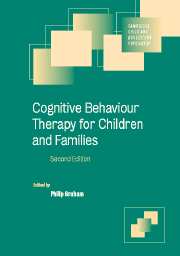Book contents
- Frontmatter
- Contents
- List of contributors
- 1 Introduction
- Part I Developmental cognitive theory and clinical practice
- Part II Engagement and assessment
- Part III Client groups
- Part IV Applications in psychosocial adversity
- Part V Applications in specific child and adolescent psychiatric disorders
- 12 Behavioural approaches to eating and sleeping problems in young children
- 13 Conduct disorders in young children
- 14 Attention deficit hyperactivity disorder
- 15 Children with developmental disabilities and their parents
- 16 Depressive disorders
- 17 Cognitive behavioural psychotherapy for obsessive compulsive disorders
- 18 Anxiety disorders
- 19 School refusal
- 20 Post-traumatic stress disorders
- 21 Disorders of eating control
- 22 Chronic fatigue syndrome
- 23 Children's interpersonal problems
- 24 Pain in childhood
- 25 Conduct disorders in adolescence
- 26 Drug and alcohol abuse
- Part VI CBT applications in preventive interventions
- Index
- References
13 - Conduct disorders in young children
Published online by Cambridge University Press: 21 August 2009
- Frontmatter
- Contents
- List of contributors
- 1 Introduction
- Part I Developmental cognitive theory and clinical practice
- Part II Engagement and assessment
- Part III Client groups
- Part IV Applications in psychosocial adversity
- Part V Applications in specific child and adolescent psychiatric disorders
- 12 Behavioural approaches to eating and sleeping problems in young children
- 13 Conduct disorders in young children
- 14 Attention deficit hyperactivity disorder
- 15 Children with developmental disabilities and their parents
- 16 Depressive disorders
- 17 Cognitive behavioural psychotherapy for obsessive compulsive disorders
- 18 Anxiety disorders
- 19 School refusal
- 20 Post-traumatic stress disorders
- 21 Disorders of eating control
- 22 Chronic fatigue syndrome
- 23 Children's interpersonal problems
- 24 Pain in childhood
- 25 Conduct disorders in adolescence
- 26 Drug and alcohol abuse
- Part VI CBT applications in preventive interventions
- Index
- References
Summary
Conduct disorder (CD) is a term used to describe behaviour which includes: excessive levels of fighting or bullying; cruelty to animals or other people; severe destructiveness to property; fire-setting, stealing and repeated lying; frequent and severe temper tantrums; defiant provocative behaviour and persistent severe disobedience; and truanting from school and running away from home. As a child grows, not only do problems escalate but the response to treatment is reduced (Olweus, 1979; Patterson, 1982). Longitudinal studies indicate that CD is relatively stable over time and predicts antisocial behaviour in adult life: there are increased rates of delinquency and antisocial personality disorders (Farrington, 1995). Follow-up studies suggest high rates not only for alcoholism, substance abuse, physical illness, suicide and accidental death but also for widespread social dysfunction, with poor work records and difficulties in all relationships, including marital relationships (Robins and Rutter, 1990).
The prediction of antisocial behaviour is stronger for men than for women. For girls, CD in childhood predicts depression and anxiety disorders more strongly than antisocial behaviour and substance abuse (Robins and Price, 1991).
In addition to antisocial behaviours, there may be coexisting attention deficit and hyperactivity, frequently including cognitive deficits and academic failure (Moffitt, 1990a, b; Moffitt and Henry, 1991; Farrington, 1995). This is associated with particularly poor outcome (Sturge, 1982; Taylor et al., 1996).
Younger children are more likely to show the signs of oppositional defiant disorder (ODD) which is classified as a subtype of CD in ICD-10 (World Health Organization, 1996), characterized by markedly defiant, disobedient and disruptive behaviour that does not include delinquent acts or the more extreme forms of aggressive or antisocial behaviour.
- Type
- Chapter
- Information
- Cognitive Behaviour Therapy for Children and Families , pp. 207 - 224Publisher: Cambridge University PressPrint publication year: 2004



